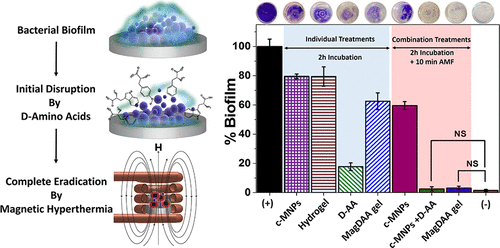当前位置:
X-MOL 学术
›
ACS Infect. Dis.
›
论文详情
Our official English website, www.x-mol.net, welcomes your
feedback! (Note: you will need to create a separate account there.)
Magnetic Glycol Chitin-Based Hydrogel Nanocomposite for Combined Thermal and d-Amino-Acid-Assisted Biofilm Disruption
ACS Infectious Diseases ( IF 4.0 ) Pub Date : 2018-05-18 00:00:00 , DOI: 10.1021/acsinfecdis.8b00076 Eric C. Abenojar 1 , Sameera Wickramasinghe 1 , Minseon Ju 1 , Sarika Uppaluri 1 , Alison Klika 2 , Jaiben George 2 , Wael Barsoum 2 , Salvatore J. Frangiamore 3 , Carlos A. Higuera-Rueda 2 , Anna Cristina S. Samia 1
ACS Infectious Diseases ( IF 4.0 ) Pub Date : 2018-05-18 00:00:00 , DOI: 10.1021/acsinfecdis.8b00076 Eric C. Abenojar 1 , Sameera Wickramasinghe 1 , Minseon Ju 1 , Sarika Uppaluri 1 , Alison Klika 2 , Jaiben George 2 , Wael Barsoum 2 , Salvatore J. Frangiamore 3 , Carlos A. Higuera-Rueda 2 , Anna Cristina S. Samia 1
Affiliation

|
Bacterial biofilms are highly antibiotic resistant microbial cell associations that lead to chronic infections. Unlike free-floating planktonic bacterial cells, the biofilms are encapsulated in a hardly penetrable extracellular polymeric matrix and, thus, demand innovative approaches for treatment. Recent advancements on the development of gel-nanocomposite systems with tailored therapeutic properties provide promising routes to develop novel antimicrobial agents that can be designed to disrupt and completely eradicate preformed biofilms. In our study, we developed a unique thermoresponsive magnetic glycol chitin-based nanocomposite containing d-amino acids and iron oxide nanoparticles, which can be delivered and undergoes transformation from a solution to a gel state at physiological temperature for sustained release of d-amino acids and magnetic field actuated thermal treatment of targeted infection sites. The d-amino acids in the hydrogel nanocomposite have been previously reported to inhibit biofilm formation and also disrupt existing biofilms. In addition, loading the hydrogel nanocomposite with magnetic nanoparticles allows for combination thermal treatment following magnetic field (magnetic hyperthermia) stimulation. Using this novel two-step approach to utilize an externally actuated gel-nanocomposite system for thermal treatment, following initial disruption with d-amino acids, we were able to demonstrate in vitro the total eradication of Staphylococcus aureus biofilms, which were resistant to conventional antibiotics and were not completely eradicated by separate d-amino acid or magnetic hyperthermia treatments.
中文翻译:

磁性乙二醇几丁质基水凝胶纳米复合材料,用于热和d-氨基酸辅助的生物膜破坏。
细菌生物膜是高度抗生素抗性的微生物细胞缔合体,可导致慢性感染。与自由漂浮的浮游细菌细胞不同,生物膜被包裹在几乎不渗透的细胞外聚合物基质中,因此需要创新的治疗方法。具有定制治疗特性的凝胶-纳米复合材料系统的最新进展为开发新型抗微生物剂提供了有前途的途径,这些抗微生物剂可被设计为破坏并完全消灭预先形成的生物膜。在我们的研究中,我们形成了独特的热反应型甲壳素磁乙二醇含有纳米复合材料d-氨基酸和氧化铁纳米粒子,可以在生理温度下递送并经历从溶液到凝胶状态的转变,以持续释放d-氨基酸和磁场驱动的目标感染部位热处理。所述d α-氨基酸在水凝胶中的纳米复合材料先前已经报道抑制生物膜的形成,并且还破坏现有生物膜。另外,用磁性纳米颗粒加载水凝胶纳米复合材料允许在磁场(磁热疗)刺激之后进行组合热处理。使用这种新颖的两步法,利用d初始破坏后,利用外部驱动的凝胶-纳米复合材料系统进行热处理-氨基酸,我们能够在体外证明金黄色葡萄球菌生物膜的全部根除,这些生物膜对常规抗生素具有抗药性,并且不能通过单独的d-氨基酸或磁热疗彻底根除。
更新日期:2018-05-18
中文翻译:

磁性乙二醇几丁质基水凝胶纳米复合材料,用于热和d-氨基酸辅助的生物膜破坏。
细菌生物膜是高度抗生素抗性的微生物细胞缔合体,可导致慢性感染。与自由漂浮的浮游细菌细胞不同,生物膜被包裹在几乎不渗透的细胞外聚合物基质中,因此需要创新的治疗方法。具有定制治疗特性的凝胶-纳米复合材料系统的最新进展为开发新型抗微生物剂提供了有前途的途径,这些抗微生物剂可被设计为破坏并完全消灭预先形成的生物膜。在我们的研究中,我们形成了独特的热反应型甲壳素磁乙二醇含有纳米复合材料d-氨基酸和氧化铁纳米粒子,可以在生理温度下递送并经历从溶液到凝胶状态的转变,以持续释放d-氨基酸和磁场驱动的目标感染部位热处理。所述d α-氨基酸在水凝胶中的纳米复合材料先前已经报道抑制生物膜的形成,并且还破坏现有生物膜。另外,用磁性纳米颗粒加载水凝胶纳米复合材料允许在磁场(磁热疗)刺激之后进行组合热处理。使用这种新颖的两步法,利用d初始破坏后,利用外部驱动的凝胶-纳米复合材料系统进行热处理-氨基酸,我们能够在体外证明金黄色葡萄球菌生物膜的全部根除,这些生物膜对常规抗生素具有抗药性,并且不能通过单独的d-氨基酸或磁热疗彻底根除。











































 京公网安备 11010802027423号
京公网安备 11010802027423号